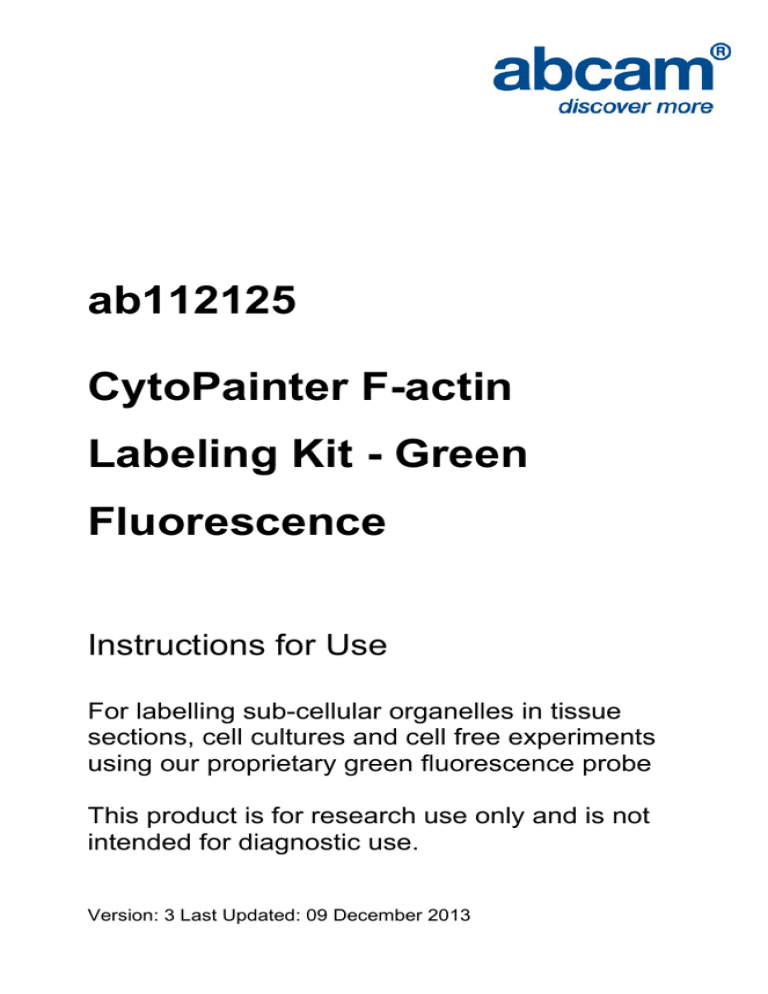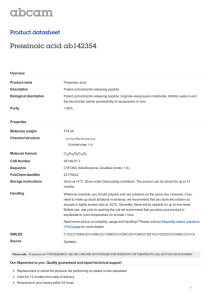
ab112125
CytoPainter F-actin
Labeling Kit - Green
Fluorescence
Instructions for Use
For labelling sub-cellular organelles in tissue
sections, cell cultures and cell free experiments
using our proprietary green fluorescence probe
This product is for research use only and is not
intended for diagnostic use.
Version: 3 Last Updated: 09 December 2013
1
Table of Contents
1.
Introduction
3
2.
Protocol Summary
5
3.
Kit Contents
6
4.
Storage and Handling
6
5.
Assay Protocol
7
6.
Data Analysis
12
2
1. Introduction
Actin is a globular, roughly 42-kDa protein found in almost all
eukaryotic cells. It is also one of the most highly-conserved proteins,
differing by no more than 20% in species as diverse as algae and
humans. Actin is the monomeric subunit of two types of filaments in
cells: microfilaments, one of the three major components of the
cytoskeleton, and thin filaments, part of the contractile apparatus in
muscle cells. Thus, actin participates in many important cellular
processes including muscle contraction, cell motility, cell division and
cytokinesis, vesicle and organelle movement, cell signaling, as well
as the establishment and maintenance of cell junctions and cell
shape.
Abcam CytoPainter imaging kits are a set of fluorescence imaging
tools for labeling sub-cellular organelles such as membranes,
lysosomes, mitochondria, nuclei, etc. The selective labeling of live
cell compartments provides a powerful method for studying cellular
events in a spatial and temporal context.
ab112125 is designed to label F-actins in fixed cells with green
fluorescence. The kit uses a green fluorescent phalloidin conjugate
that selectively binds to F-actins. When used at nanomolar
concentrations, phallotoxins are convenient probes for labeling,
identifying and quantitating F-actins in formaldehyde-fixed and
permeabilized tissue sections, cell cultures or cell-free experiments.
3
ab112125 provides all the essential components with an optimized
staining protocol, which is robust requiring minimal hands-on time.
The phalloidin conjugate has spectral properties similar to those of
FITC (Ex/Em = 500/520 nm).
4
2. Protocol Summary
Summary for One 96-well Plate
Prepare samples (microplate wells)
Remove the liquid from the plate
Add 100 μL/well of Green Fluorescent Phalloidin
Conjugate solution
Stain the cells at RT for 15 – 60 minutes
Wash the cells
Examine the specimen under microscope at
Ex/Em = 488/520 nm
5
Note: Thaw all the kit components to room temperature before
starting the experiment.
3. Kit Contents
Components
Component A: Green Fluorescent Phalloidin
Amount
50 µL
Conjugate
Component B: Labeling Buffer
50 mL
4. Storage and Handling
Keep at -20°C. Avoid exposure to light.
6
5. Assay Protocol
Note: This protocol is for one 96 - well plate.
F-ACTIN STAINING ONLY
A. Preparation of 1X Green Fluorescent Phalloidin Conjugate
Working Solution
Add
10
µL
of
Green
Fluorescent
Phalloidin
Conjugate
(Component A) to 10 mL of Labeling Buffer (Component B).
Note 1: The unused Green Fluorescent Phalloidin Conjugate
stock solution (Component A) should be aliquoted and stored at
-20oC. Protect from light.
Note 2: Different cell types might be stained differently. The
concentration of Green Fluorescent Phalloidin Conjugate working
solution should be prepared accordingly.
B. Staining the Cells
1. Perform formaldehyde fixation. Incubate the cells with 3.0–
4.0 % formaldehyde in PBS at room temperature for 10 – 30
minutes.
7
Note: Avoid any methanol containing fixatives since methanol can
disrupt actin during the fixation process. The preferred fixative is
methanol-free formaldehyde
2. Rinse the fixed cells 2–3 times in PBS.
3. Optional: Add 0.1% Triton X-100 in PBS into fixed cells (from
Step B.2) for 3 – 5 minutes to increase permeability. Rinse
the cells 2–3 times in PBS.
4. Add 100 μL/well (96-well plate) of 1x Green Fluorescent
Phalloidin Conjugate working solution (from Step A) into the
fixed cells (from Step B.2 or B.3), and stain the cells at room
temperature for 15 – 60 minutes
5. Rinse cells gently with PBS 2 – 3 times to remove excess dye
before plate sealing and imaging by using FITC channel.
8
ANTIBODY AND F-ACTIN COMBINATION STAINING
Note: This protocol is for one 96 - well plate.
A. Preparation of 1X Green Fluorescent Phalloidin Conjugate
Solution
Add 10 µL Green Fluorescent Phalloidin Conjugate (Component
A) to 10 mL of Labeling Buffer (Component B).
Note 1: The unused Green Fluorescent Phalloidin Conjugate
stock solution (Component A) should be aliquoted and stored at
-20oC. Protect from light.
Note 2: Different cell types might be stained differently. The
concentration of Green Fluorescent Phalloidin Conjugate working
solution should be prepared accordingly.
B. Staining the Cells
1. Perform formaldehyde fixation. Incubate the cells with 3.0 –
4.0 % formaldehyde in PBS at room temperature for 10 – 30
minutes.
Note: Avoid any methanol containing fixatives since methanol can
disrupt actin during the fixation process. The preferred fixative is
methanol-free formaldehyde
2. Rinse the fixed cells 2 – 3 times in PBS.
9
3. Permeabilize fixed cells with 0.2% Triton X-100 in PBS;
incubate for 10 – 30 minutes to increase permeability. Rinse
the cells once with PBS.
4. Add 100 µl/well 5% Goat serum and leave for 30 minutes.
Aspirate serum but do not rinse.
5. Add 100µl of primary antibody solution with 0.5% BSA in PBS
and incubate for 1 hour. Make sure the entire are is covered.
6. Rinse cells 3 times in PBS, each time for 5 minutes. Aspirate
PBS.
7. Add Goat serum, incubate for 1 – 2 minutes and aspirate.
8. Add 100 μL/well of secondary antibody solution diluted in
0.5% BSA in PBS buffer and 100 μL/well 1X Green
Fluorescent Phalloidin Conjugate (from Step A) working
solution and stain the cells at room temperature for 30 – 60
minutes. Keep in the dark.
9. If desired, add nuclear dye at relevant dilution in 0.5% BSA in
PBS and incubate 10 – 30 minutes. Wash cells 2 – 3 times
for 5 minutes in PBS.
Note: do not use a green fluorescent dye as nuclear dye with
this product as it emits in the same channel and the signal
10
will be masked. We recommend using DRAQ5 (ab108410) as
it emits on the far red.
10. Seal plate and examine samples in fluorescence microscope
using green (FITC) channel (Ex/Em = 490/525 nm) for F-actin
staining. Use the appropriate channels to detect your
secondary antibody and nuclear staining
11
6. Data Analysis
A
B
Figure 1. Image of CPA cells fixed with formaldehyde and stained
with ab112125 in a black 96-well plate.
A: Cells were labeled with 1X Green Fluorescent Phalloidin
Conjugate for 30 minutes only.
B: Cells were pre-treated with phalloidin for 10 minutes, then stained
with 1X Green Fluorescent Phalloidin Conjugate for 30 minutes.
For further technical questions please do not hesitate to
contact us by email (technical@abcam.com) or phone (select
“contact us” on www.abcam.com for the phone number for
your region).
12
13
14
UK, EU and ROW
Email: technical@abcam.com | Tel: +44(0)1223-696000
Austria
Email: wissenschaftlicherdienst@abcam.com | Tel: 019-288-259
France
Email: supportscientifique@abcam.com | Tel: 01-46-94-62-96
Germany
Email: wissenschaftlicherdienst@abcam.com | Tel: 030-896-779-154
Spain
Email: soportecientifico@abcam.com | Tel: 911-146-554
Switzerland
Email: technical@abcam.com
Tel (Deutsch): 0435-016-424 | Tel (Français): 0615-000-530
US and Latin America
Email: us.technical@abcam.com | Tel: 888-77-ABCAM (22226)
Canada
Email: ca.technical@abcam.com | Tel: 877-749-8807
China and Asia Pacific
Email: hk.technical@abcam.com | Tel: 108008523689 (中國聯通)
Japan
Email: technical@abcam.co.jp | Tel: +81-(0)3-6231-0940
www.abcam.com | www.abcam.cn | www.abcam.co.jp
15
Copyright © 2013 Abcam, All Rights Reserved. The Abcam logo is a registered trademark.
All information / detail is correct at time of going to print.






